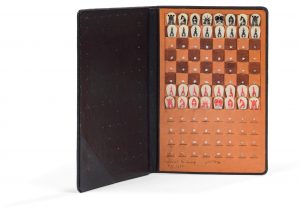How To Elevate Your Collection With Vintage Ephemera

Vintage ephemera stands alone as a collecting category, but it is also a marvelous compliment to others. The Ephemera Society of America defines ephemera as, “vintage printed or written items which originally served some specific purpose and were not expected to be retained or preserved, but which are now cherished.”
With this wide definition, ephemera can be a natural extension to any specific collection. It can provide a whole new dimension or energy to a collection, especially one that’s mature or needs a little spark. Examples can be relatively inexpensive, accessible, and easy to display or store.
For example, I have been a fan of Teddy bears, dolls, and animals made by the Steiff Company for almost half a century. Although there are always new discoveries on the horizon, after five decades of collecting, my cabinets are full. And, for the most part, I have an example of almost everything that I know of in my collection. By including ephemera in my collecting pursuits, I have opened new doors to discovery and increased my interest in my Steiff arsenal. And these printed items really look charming displayed along with their 3D counterparts!

What forms of ephemera might catch a collector’s eye? Items including print advertisements, posters and broadsides, catalogs and brochures, photographs, mailers and postcards, and company or manufacturer’s paperwork (like internal or planning documents). These are treasure-troves of information for people who are fans of a specific company, organization, or artist. For history buffs, old maps may tell new stories. Meanwhile, for those with destination-specific passions, matchbooks, travel tickets, and menus may ignite new collecting directions.
There is so much to learn from ephemera. Stories are everywhere, often hiding in plain sight. For example, advertisements can reveal partnerships between companies in the form of product placement. Addresses noted on letterhead can document physical moves and relocations. And price tags can reawaken the history of once mighty retailers who have since gone out of business or have been absorbed into larger chains today.
Vintage print catalogs, produced by a company, manufacturer, or artist, retailer, or distribution partner, are ripe with interesting content. Here are three cool, not so obvious things collectors can learn from them in relation to their collecting interests.

Historical Grounding and Context
Vintage catalogs are time capsules in themselves. Pay attention to the cover image; usually, it is a mirror of the organization’s priorities and realities of the time. It can be aspirational, signal a change in strategy, spotlight debuts, and/or reflect the current state of the marketplace or world.

For example, the early 1940s Steiff catalog cover above features a rosy child against a black background and the company’s most – and still – legacy product. It projects no-frills stability and a focus on core toy production despite the realities of World War II. No new products are featured, which suggests that this was not a priority at the time. Fast forward to the early 1950s, the company’s catalog covers entirely spotlight new products, interacting playfully against light backgrounds.
Product Production and Partnership Insights
Catalogs are an archive of production over time. As a collector, it is thrilling to flip through a vintage company catalog and spot items that you were unaware of or that did not appear in other documentation. It is likely that these items never went into full production or had manufacturing or distribution issues limiting output. Retailer catalogs can also reveal little known collaborations in the form of special edition rarities produced exclusively for them.

For example, the 1931 Steiff catalog page above shows a number of handbag and pincushion novelties. All are well known and coveted by collectors except for the bulldog purse in the upper left… because it’s most likely the first (and perhaps the only) time it was promoted. Of course, its rarity has catapulted it to the top of my personal collecting wish list!
Meanwhile, the 1968/1969 F.A.O. Schwarz catalog below finally solved the origins of this otherwise undocumented squirrel from my collection. It is noted as, “Tame and friendly, this begging grey squirrel in soft plush, has a long bushy tail and looks very natural. 7-1/2″ tall. Ship wt. 2 lbs. $6.95.”

Relative Pricing Comparisons
Vintage ephemera related to prices can take a few forms, including price sheets or tags, or prices noted in ads, catalogs, or mailers. This information allows collectors to figure out how much something cost at the time of its debut and what that would mean in today’s dollars. This data sheds light on relative value over time.

For example, the 1910 print advertisement above from F.A.O. Schwarz pictures three Steiff dolls in the upper right hand corner. They range in price from $2.00 to $2.25. Using an online inflation calculator, this translates to about $54 to $61 in purchasing power today. Since its beginnings in the late 1880s, Steiff has always positioned itself as a premium brand. These prices reflect that more than a century onward.
For more information on ephemera, please see the Ephemera Society of America’s website. Rebekah Kaufman is a regular contributor to numerous international print and online publications, lectures across the US and Europe, and provides vintage Steiff consulting and expertise to the media, auction houses, and industry partners. She has no affiliation with Margarete Steiff GmbH or Steiff North America. For more information on vintage Steiff, read Kaufman’s spotlight on Steiff collectibles from earlier this year or visit her blog, My Steiff Life.










